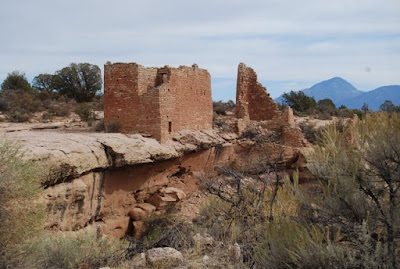After Four Corners, our next stop was Hovenweep National Monument. A Morman expedition led by W.D. Huntington discovered the abandoned remains of a civilization in 1854. Hovenweep is the Ute word for deserted valley and was adopted by pioneer photographer William Henry Jackson in 1874. In 1923, President Harding declared Hovenweep a unit of the National Park System.
 After watching a movie at the Visitor's Center and before taking the hike around Square Tower Group, we decided it was time for lunch. As we ate lunch outside at a picnic table, we were visited by the very assuming Scrub Jay that we would give him a handout. John put a walnut out at the end of the table and in he flew and picked up the nut and flew off. This was to be repeated numerous times. We even got to watch him bury one of the nuts near where we were sitting. That was interesting. I wonder how he will find his treasures later on.
After watching a movie at the Visitor's Center and before taking the hike around Square Tower Group, we decided it was time for lunch. As we ate lunch outside at a picnic table, we were visited by the very assuming Scrub Jay that we would give him a handout. John put a walnut out at the end of the table and in he flew and picked up the nut and flew off. This was to be repeated numerous times. We even got to watch him bury one of the nuts near where we were sitting. That was interesting. I wonder how he will find his treasures later on. The towers of Hovenweep were built by Ancestral Puebloans between A.D. 1200 to A.D. 1300. The buildings are of various size and shape. The masonry is skillful and beautiful. We marveled at how they rounded edges and made square cuts to the rocks. How did they do that? What is even more amazing, is that after 700 years so much of the buildings are still standing. We took the hike around Square Tower Group as it has the most structures in a defined area.
The towers of Hovenweep were built by Ancestral Puebloans between A.D. 1200 to A.D. 1300. The buildings are of various size and shape. The masonry is skillful and beautiful. We marveled at how they rounded edges and made square cuts to the rocks. How did they do that? What is even more amazing, is that after 700 years so much of the buildings are still standing. We took the hike around Square Tower Group as it has the most structures in a defined area. Archaeologists have found most of the towers were associated with kivas (Puebloan ceremonial structures - usually circular) but their true purpose remains a mystery. Were they defensive in nature, celestrial observatories, storage facilities, or simply fancy homes? No one knows.
Archaeologists have found most of the towers were associated with kivas (Puebloan ceremonial structures - usually circular) but their true purpose remains a mystery. Were they defensive in nature, celestrial observatories, storage facilities, or simply fancy homes? No one knows.By the end of the 13th century, the area was vacated. Why, no one really knows but there is a lot of speculation: drought, lack of food, warfare. What they do know is that Ancestral Puebloans migrated south to the Rio Grande Valley in New Mexico and the Little Colorado Basin in Arizona. Zuni, Hopi, and Pueblo Indians are descendants of this culture.
Here we were in the middle of nowhere and yet there remains proof that at one time, this area was alive with farming, families, and social networks. Makes you wonder what this area looked like way back then - maybe it was a green oasis a stark contrast to the desert it is today.








No comments:
Post a Comment